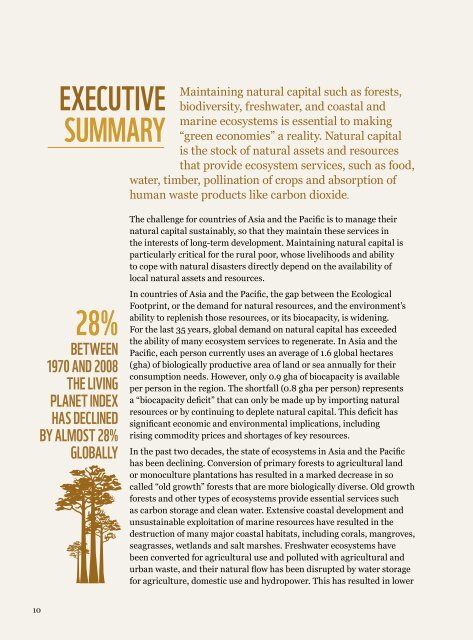Download the pdf - Global Footprint Network
Download the pdf - Global Footprint Network
Download the pdf - Global Footprint Network
Create successful ePaper yourself
Turn your PDF publications into a flip-book with our unique Google optimized e-Paper software.
10<br />
eXeCutIve<br />
suMMARY<br />
28%<br />
BetWeen<br />
1970 AnD 2008<br />
<strong>the</strong> LIvIng<br />
PLAnet InDeX<br />
hAs DeCLIneD<br />
BY ALMost 28%<br />
gLoBALLY<br />
Maintaining natural capital such as forests,<br />
biodiversity, freshwater, and coastal and<br />
marine ecosystems is essential to making<br />
“green economies” a reality. Natural capital<br />
is <strong>the</strong> stock of natural assets and resources<br />
that provide ecosystem services, such as food,<br />
water, timber, pollination of crops and absorption of<br />
human waste products like carbon dioxide.<br />
The challenge for countries of Asia and <strong>the</strong> Pacific is to manage <strong>the</strong>ir<br />
natural capital sustainably, so that <strong>the</strong>y maintain <strong>the</strong>se services in<br />
<strong>the</strong> interests of long-term development. Maintaining natural capital is<br />
particularly critical for <strong>the</strong> rural poor, whose livelihoods and ability<br />
to cope with natural disasters directly depend on <strong>the</strong> availability of<br />
local natural assets and resources.<br />
In countries of Asia and <strong>the</strong> Pacific, <strong>the</strong> gap between <strong>the</strong> Ecological<br />
<strong>Footprint</strong>, or <strong>the</strong> demand for natural resources, and <strong>the</strong> environment’s<br />
ability to replenish those resources, or its biocapacity, is widening.<br />
For <strong>the</strong> last 35 years, global demand on natural capital has exceeded<br />
<strong>the</strong> ability of many ecosystem services to regenerate. In Asia and <strong>the</strong><br />
Pacific, each person currently uses an average of 1.6 global hectares<br />
(gha) of biologically productive area of land or sea annually for <strong>the</strong>ir<br />
consumption needs. However, only 0.9 gha of biocapacity is available<br />
per person in <strong>the</strong> region. The shortfall (0.8 gha per person) represents<br />
a “biocapacity deficit” that can only be made up by importing natural<br />
resources or by continuing to deplete natural capital. This deficit has<br />
significant economic and environmental implications, including<br />
rising commodity prices and shortages of key resources.<br />
In <strong>the</strong> past two decades, <strong>the</strong> state of ecosystems in Asia and <strong>the</strong> Pacific<br />
has been declining. Conversion of primary forests to agricultural land<br />
or monoculture plantations has resulted in a marked decrease in so<br />
called “old growth” forests that are more biologically diverse. Old growth<br />
forests and o<strong>the</strong>r types of ecosystems provide essential services such<br />
as carbon storage and clean water. Extensive coastal development and<br />
unsustainable exploitation of marine resources have resulted in <strong>the</strong><br />
destruction of many major coastal habitats, including corals, mangroves,<br />
seagrasses, wetlands and salt marshes. Freshwater ecosystems have<br />
been converted for agricultural use and polluted with agricultural and<br />
urban waste, and <strong>the</strong>ir natural flow has been disrupted by water storage<br />
for agriculture, domestic use and hydropower. This has resulted in lower

















